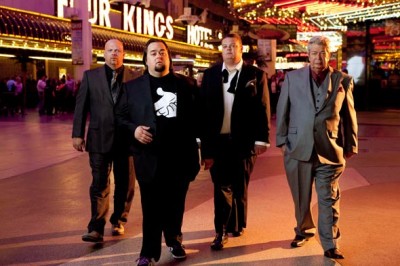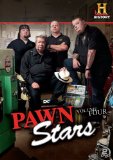| Reviews & Columns |
|
Reviews DVD TV on DVD Blu-ray 4K UHD International DVDs In Theaters Reviews by Studio Video Games Features Collector Series DVDs Easter Egg Database Interviews DVD Talk Radio Feature Articles Columns Anime Talk DVD Savant Horror DVDs The M.O.D. Squad Art House HD Talk Silent DVD
|
DVD Talk Forum |
|
|
| Resources |
|
DVD Price Search Customer Service #'s RCE Info Links |
|
Columns
|
|
|
Pawn Stars - Volume Four
Regardless, Pawn Stars - Volume Four includes 16 more shows, this time the last ten episodes of season three and the first six of season four. Got that?
And, in any case, aesthetically Pawn Stars changes not in the slightest, even between the season three and four shows. As before, the program follows the appraising and haggling of rare and oddball items at the Gold & Silver Pawn Shop, a surprisingly upscale joint in Las Vegas. The shop is co-owned by Rick Harrison (who resembles Michael Chiklis) and his cantankerous, self-consciously colorful father, Richard ("the Old Man"). Together they're grooming Rick's son, Corey (also known as "Big Hoss"), to eventually run the store. But he and Corey's dim-witted pal Chumlee often get into trouble, buying expensive items without proper authorization.
The DVD, distributed by New Video, is properly presented in 16:9 enhanced widescreen, but has no extra features.
I don't have much to add about the show that I didn't already say in my reviews of season two and volume three, though I've included a few notes about this specific set below.
If you're thinking about selling a family heirloom, Pawn Stars is a good primer to learn a thing or two about the art of haggling. For instance, the seller is in a much better position to negotiate if he's done his research beforehand, finding similar items on the Internet and having some idea of just what it is he's trying to sell. Paperwork documenting the item's history is also useful. And, if you watch the show enough, it's pretty obvious what to reasonably expect.
If the various pawnbrokers actually want to buy your item, their usual offer is between 40-45% of what they think they can sell it for. Too often sellers are told by the program's independent experts - "Let me call a buddy of mine who's an expert in this sort of stuff," Rick'll say - that an item is worth, say, between $3,000 and $5,000. When Rick then asks, "So, how much were you looking to get out of this item?" the seller almost invariably knee-jerk responds with, "$5,000!" Cut to Rick rolling his eyes or replying with a deadpan, "Ah, no."
What it boils down to are factors like the size of the item (too big or too vast and it becomes more trouble than it's worth; they tend to avoid vast collections of toys and comic books because of the man-hours that would be tied up trying to sell everything), how quickly it can be sold, and the market for that particular item. (George Washington? Hot. Baseball cards? Ice cold.) Oftentimes customers will bring in something utterly fascinating but also too unique, so uncategorical that, neat as it is, there's just no market. To his credit, Rick is understandably leery of things like Nazi memorabilia, torture devices, and certain kinds of weapons, even though these items would probably sell.
If the shop does want to buy your item, that narrow range of 40-45% is about all one can reasonably expect. When a customer brings in something truly outstanding, Rick will go higher than 50%, particularly if the item's value is rock solid and he's certain it has broad appeal, like gold jewelry.
It's also interesting watching the very different haggling tactics of Rick, Richard, and Corey. The Old Man uses his intimidating, imposing and poker-faced presence in an Old School haggler way that contrasts Rick and Corey. If the Old Man offers $100 for something and the customer counters with $150, the Old Man is apt to reply, "How about $50?"
Rick, on the other hand, grins like the Cheshire Cat and snickers just like this character to ease negotiations through awkward moments, and is always extremely polite even with customers trying to unload worthless junk ("But, gee - thanks for bringing this in to show me. It's really neat.") Corey, less experienced and neither as intimidating as the Old Man nor as smooth and sociable as his father, knows the numbers he has to work with but lacks their confidence. Rarely, for instance, does he look his customers in the eyes during critical bargaining moments.
In Volume Four, Chumlee's role as comedy relief is expanded. While the viewing and haggling over items is obviously real if pre-screened and carefully selected by the producers, and filmed in an controlled shooting environment, the filler between these segments is all too obviously scripted, though some are perhaps suggested by real-life anecdotes and are reenacted/improvised. There's even a dream sequence in one show.
The most surprising of these involves Chumlee's encounter with Bob Dylan (in "Like a Rolling Chum"), as bizarre a collision in the pop culture universe as when Mae West met Mr. Ed. In this episode Rick learns Bob Dylan is in town for a concert so he dispatches Chumlee with a Dylan LP on the off chance he can get the singer-songwriter to sign it, thus increasing its value exponentially. Miraculously, Chumlee encounters Dylan on The Strip, the musician appearing genuinely baffled by the brief meeting. But, alas, Chumlee asks that the record be signed "To Chumlee," ruining Rick's grand plans.
(These scripted/improvised scenes peculiarly recast Rick as a real hothead, forever ready to lash out at Corey and Chumlee, making him appear less the gregarious pawnbroker of earlier seasons.)
As always, the items brought in are endlessly fascinating, this set including such things as a white suit owned by Kentucky Fried Chicken's Col. Sanders; a 1981 DeLorean DMC-12; Sammy Davis Jr.'s video collection; a bleacher seat taken from Yankee Stadium; items that once belonged to Wyatt Earp; handcuffs and leg shackles once owned by Harry Houdini, and much, much more.
Video & Audio
Happily, Pawn Stars - Volume Four is presented in 1.78:1 widescreen with 16:9 enhancement, in a transfer up to contemporary television standards, as is its 2.0 Dolby Stereo. There are no subtitle options per se, but the discs are closed-captioned. The set includes 16 22-minute episodes on two single-sided, dual-layered discs. No Extra Features.
Parting Thoughts
As always, Pawn Stars is a genuinely fun and fascinating show, despite occasionally lame and frankly unnecessary filler. Highly Recommended.
Stuart Galbraith IV's audio commentary, for AnimEigo's Tora-san DVD boxed set, is on sale now.
|
| Popular Reviews |
| Sponsored Links |
|
|
| Sponsored Links |
|
|
| Release List | Reviews | Shop | Newsletter | Forum | DVD Giveaways | Blu-Ray | Advertise |
|
Copyright 2024 DVDTalk.com All Rights Reserved. Legal Info, Privacy Policy, Terms of Use,
Manage Preferences,
Your Privacy Choices | |||||||














